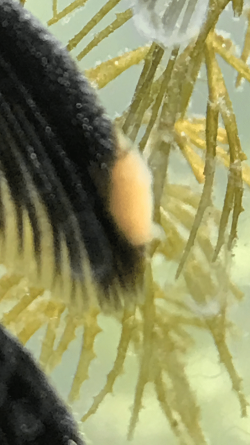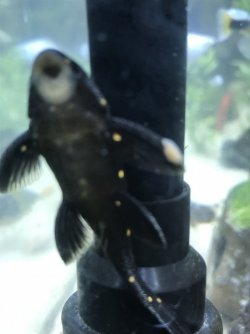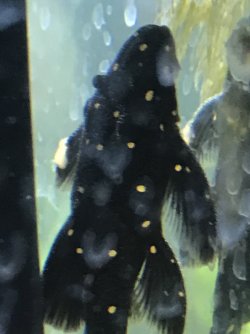Does anyone know what this little growth might be on my pleco? I’ve only had him a month, from my LFS, I wasn’t able to quarantine. No behavioural or feeding issues just this little growth that appeared on its fin last week, slightly more red at first but now this more creamy colour. Thank you.
🌟 Exclusive Amazon Black Friday Deals 2024 🌟
Don’t miss out on the best deals of the season! Shop now 🎁
You are using an out of date browser. It may not display this or other websites correctly.
You should upgrade or use an alternative browser.
You should upgrade or use an alternative browser.
Growth on pleco
- Thread starter Elena82x
- Start date
Uberhoust
Fish Herder
No idea what that is, it would be helpful, for others, if the photo was sharper, are the growths on the body similar to the one on the fins. Something doesn't look quite right. Anything else you can offer might help such as the water parameters, new additions, and history of the tank.
Thank you for your reply. The smaller spots are his colouring, I will add here the photo ID him at the LFS showing his spots. The growth on the fin is new though I’ve only had him a couple of weeks.No idea what that is, it would be helpful, for others, if the photo was sharper, are the growths on the body similar to the one on the fins. Something doesn't look quite right. Anything else you can offer might help such as the water parameters, new additions, and history of the tank.
Ammonia / nitrite 0
Nitrate about 15ppm
PH 7.6
GH 10
None of my other fish are showing any growths or marks
I just wonder if it could be fungal or bacterial and I ought to be treating it. Nothing apparent from Google searching.
I’ll try and get a better shot of him to show it better.
Attachments
FranciscoB
Fish Crazy
The white growth shown looks to be a fungal infection, possibly upon an existing injury. These infections are sometimes very stubborn. If it were me, I would use methylene blue applied by dabbing onto the growth, followed by a topical anti fungal ointment. Because of the oily ointment, a close eye on water quality is necessary, with frequent changes as needed. The treatment must be repeated until major improvement. Water quality needs to pristine.
Others may advice differently. This is what I would do. Good luck!
Others may advice differently. This is what I would do. Good luck!
Uberhoust
Fish Herder
Thanks for the clarification, I don't know much about plecos. I would suggest there are two possibilities for the growth, one it is a damaged fin that has become infected, or two it is some form of tumor or cyst. I am really not the best person for these types of issues, hopefully we can get some people with better experience to look at this. @Colin_T used to be someone who would wade into these types of questions but I haven't seen him around much lately, @GaryE might have some suggestions.
The fish might have been damaged during the capture and being placed in a new tank would increase its stress level making it more sensitive at this time.
The fish might have been damaged during the capture and being placed in a new tank would increase its stress level making it more sensitive at this time.
Thank youThe white growth shown looks to be a fungal infection, possibly upon an existing injury. These infections are sometimes very stubborn. If it were me, I would use methylene blue applied by dabbing onto the growth, followed by a topical anti fungal ointment. Because of the oily ointment, a close eye on water quality is necessary, with frequent changes as needed. The treatment must be repeated until major improvement. Water quality needs to pristine.
Others may advice differently. This is what I would do. Good luck!
Thank youThanks for the clarification, I don't know much about plecos. I would suggest there are two possibilities for the growth, one it is a damaged fin that has become infected, or two it is some form of tumor or cyst. I am really not the best person for these types of issues, hopefully we can get some people with better experience to look at this. @Colin_T used to be someone who would wade into these types of questions but I haven't seen him around much lately, @GaryE might have some suggestions.
The fish might have been damaged during the capture and being placed in a new tank would increase its stress level making it more sensitive at this time.
I have got some more photos
Attachments
-
 C1E28208-B41F-4494-A763-239736FD14DB.png520.9 KB · Views: 31
C1E28208-B41F-4494-A763-239736FD14DB.png520.9 KB · Views: 31 -
 9AD06407-C81C-42F3-9936-589F865141AF.jpeg144.9 KB · Views: 27
9AD06407-C81C-42F3-9936-589F865141AF.jpeg144.9 KB · Views: 27 -
 FDB10F5B-685E-4166-A189-8B7A5EF6C29A.jpeg230.3 KB · Views: 24
FDB10F5B-685E-4166-A189-8B7A5EF6C29A.jpeg230.3 KB · Views: 24 -
 14EA60CA-CE7B-4501-98CD-EB551FB14C4C.jpeg259.6 KB · Views: 28
14EA60CA-CE7B-4501-98CD-EB551FB14C4C.jpeg259.6 KB · Views: 28 -
 4ECFA1CC-6532-4A07-86B4-94A467BCE946.jpeg148.3 KB · Views: 26
4ECFA1CC-6532-4A07-86B4-94A467BCE946.jpeg148.3 KB · Views: 26
excess mucous or an interesting fungus. do a big water change, gravel clean the substrate, clean the filter, then add some salt.
SALT
You can add rock salt (often sold as aquarium salt), swimming pool salt, or any non iodised salt (sodium chloride) to the aquarium at the dose rate of 1 heaped tablespoon per 20 litres of water. If there is no improvement after 48 hours you can double that dose rate so there is 2 heaped tablespoons of salt per 20 litres.
Keep the salt level like this for at least 2 weeks but no longer than 4 weeks otherwise kidney damage can occur. Kidney damage is more likely to occur in fish from soft water (tetras, Corydoras, angelfish, Bettas & gouramis, loaches) that are exposed to high levels of salt for an extended period of time, and is not an issue with livebearers, rainbowfish or other salt tolerant species.
The salt will not affect the beneficial filter bacteria, fish, plants, shrimp or snails.
After you use salt and the fish have recovered, you do a 10% water change each day for a week using only fresh water that has been dechlorinated. Then do a 20% water change each day for a week. Then you can do bigger water changes after that. This dilutes the salt out of the tank slowly so it doesn't harm the fish.
If you do water changes while using salt, you need to treat the new water with salt before adding it to the tank. This will keep the salt level stable in the tank and minimise stress on the fish.
When you first add salt, add the salt to a small bucket of tank water and dissolve the salt. Then slowly pour the salt water into the tank near the filter outlet. Add the salt over a couple of minutes.
SALT
You can add rock salt (often sold as aquarium salt), swimming pool salt, or any non iodised salt (sodium chloride) to the aquarium at the dose rate of 1 heaped tablespoon per 20 litres of water. If there is no improvement after 48 hours you can double that dose rate so there is 2 heaped tablespoons of salt per 20 litres.
Keep the salt level like this for at least 2 weeks but no longer than 4 weeks otherwise kidney damage can occur. Kidney damage is more likely to occur in fish from soft water (tetras, Corydoras, angelfish, Bettas & gouramis, loaches) that are exposed to high levels of salt for an extended period of time, and is not an issue with livebearers, rainbowfish or other salt tolerant species.
The salt will not affect the beneficial filter bacteria, fish, plants, shrimp or snails.
After you use salt and the fish have recovered, you do a 10% water change each day for a week using only fresh water that has been dechlorinated. Then do a 20% water change each day for a week. Then you can do bigger water changes after that. This dilutes the salt out of the tank slowly so it doesn't harm the fish.
If you do water changes while using salt, you need to treat the new water with salt before adding it to the tank. This will keep the salt level stable in the tank and minimise stress on the fish.
When you first add salt, add the salt to a small bucket of tank water and dissolve the salt. Then slowly pour the salt water into the tank near the filter outlet. Add the salt over a couple of minutes.
Similar threads
- Replies
- 3
- Views
- 284
- Replies
- 2
- Views
- 423
- Replies
- 10
- Views
- 417




